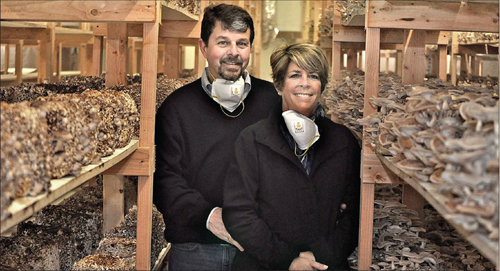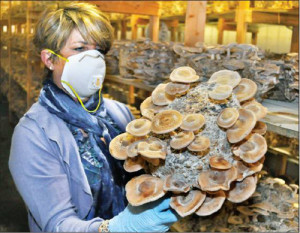Couple reunites, starts local mushroom farm

How did two people from a small town in Rhode Island, high school sweethearts who went their separate ways after graduation, wind up as sweethearts again — and as partners in a mushroom farm?

Jane Maguire and John Quigley, who launched their Long Island Mushroom company in a former food storage building not far from the old dump, grinned at the question.
“We still don’t know,” she said.
What they do know is that growing mushrooms as a couple is the second chapter of their lives.
They grow shiitakes, a lot of them, and soon will add the oyster variety.
Beneath their modest second-fl oor office is a 6,500-square-foot space where rows of wooden racks reach toward the high ceiling, holding more than 2,000 oval pressed paper and sawdust “logs.” Each log is about eight inches high and 12 inches long and is “inoculated” with mushroom spores and later soaked in water. The logs come from Pennsylvania, which Ms. Maguire described as “the mushroom-growing capital of the United States.”
The room is kept at a constant 63 to 65 degrees with 95 to 97 percent humidity and anyone entering must wear a dust mask to keep from breathing in unseen spores. In time, each log will produce a bloom of shiitake mushrooms that are harvested by simply snapping them off. The logs go through three 16-day growing cycles before they’re replaced.
In a nearby refrigerated storage room, mushrooms awaiting dehydration sit in some of the 106 run-of-the-mill plastic laundry baskets purchased from Target and BJ’s Wholesale Club.
“We took every one they had,” Mr. Quigley said of the laundry baskets. “We had them stacked so high in the cart we couldn’t see in front of us.”
On the other side is a pile of cylindrical black plastic bags filled with straw and mushroom spores. They’ll hang in a separate part of the building and, by later this month, will begin to sprout blue oyster mushrooms. That variety requires a somewhat lower temperature and just about 100 percent humidity.
Long Island Mushroom claims the title of the North Fork’s only such fungus farm and is one of only two on the East End. (The other’s in Bridgehampton.) They chose the much-prized umbrella-shaped shiitakes, Ms. Maguire said, because they’re clean and relatively easy to grow.
The variety Lentinus edodes comes from Asia and its name is a combination of the Japanese words “shi,” the Japanese evergreen where they’re often found, and “take,” which means mushroom.
“I wonder why no one else does this,” said Mr. Quigley, who left behind careers in finance and construction in Pennsylvania.
To answer his own question, he said the learning curve on mushroom growing is steep and few can offer advice or insight on how to proceed and what to expect — especially on the fi – nancial end.
Perhaps most important, he said, “You have to have a passion for this.”
Not to mention an initial investment he described as “very substantial.”
It’s certainly not the future they envisioned after graduating from high school in Middletown, R.I., not far from Newport’s imposing mansions and ritzy yachts.
“If anyone had told me a few years back that I’d be doing this today I’d have told them they were crazy,” said Mr. Quigley. “But you get to a point in your life where money is no longer the object and you look for something intriguing.”
As for him and Ms. Maguire, “We lost track of each other for 32 years,” he said. “Then we found each other.”
Last July they also found a man with the idea of opening a mushroom farm from scratch, which they found intriguing. After committing to the venture, they moved into the Cutchogue facility in September and produced their first mushroom crop over the winter.
The couple considered contracting with food wholesalers but discovered that wasn’t cost effective. Ms. Maguire is looking for buyers chef by chef and restaurant by restaurant. As the weather warms she’ll be going farm stand by farm stand as well.
They’ve got a lot to sell, growing about 700 pounds a day, or about 21,000 pounds per month. Their goal is to distribute 40 percent fresh; 40 percent dehydrated, as a cooking ingredient; and 20 percent as specialty food products. They’ve no plans for a stand or a retail shop, but they have created a subsidiary, Out East Specialties, producing jars of mushroom tapanade, a spread made of chopped mushrooms and other ingredients, such as eggplant.
The recipes were developed through trial and error at the Stony Brook University business incubator in Calverton. Through its Open House Kitchen, the incubator provides access to commercial-grade food preparation facilities and the mushroom company brings in a chef and the raw materials.
While living and working on the North Fork is old hat for Ms. Maguire, a resident for 17 years, her partner, who had never set foot on Long Island before 2009, was amazed to fi nd that it’s not all shopping malls and housing developments.
“I felt like Columbus stepping on a foreign land,” he said. “I didn’t know how spectacularly beautiful it is.”
They’re now happily enjoying small town life in Mattituck.
Although their hometown doesn’t have an easygoing sheriff or a high-strung deputy, “Mayberry,” Mr. Quigley said, “is a wonderful place.”





